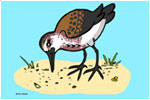| |
|
Chapter 2: Maya Gets Ready 
In part I'm nervous because my body tells me to eat faster, eat faster!!! This is an unsettling feeling. I'm trying to eat as much as I possibly can. My body says, "stuff yourself!" before taking off for spring migration. Oxy and Maria are puzzled by many of the same things and share some of the same fears, although everyone agrees that I ask too many questions and have far too active an imagination for my own good!
From my vantage point on the shoreline, I can see my brother, Jorge, in shallow water, probing in the sand with his beak for aquatic insects and invertebrates. He, like all of us, is working on increasing his body weight by 50%! Can you imagine? If you weighed 75 pounds you would weigh 112.5 pounds in just a week! That is one gigantic difference. And he will soon lift off the ground in spite of this load! I am envious that he has migrated several times already and knows all the tricks of survival as well as the lay of the land.
I'm amazed that Jorge can continue to noodle around in the mud--non-stop--without stopping for a break. Even if Maria or Oxy tease him by screeching, he ignores them and continues to search for little marine worms. No doubt in the back of his mind he's thinking about how he can get them back later.
The sun is now setting and I admit that I am tired from gorging on so many little marine critters. But more than that, I am frustrated that my parents and Jorge cannot explain something so simple: why do we have to take such a huge journey? Their answers are always different. My mother says it's because we need to take advantage of the plentiful insect life in the Arctic during the summer months. No one disagrees with her, but my father says it's because we have some instinctual need or urge to head north, one that has existed for many, many generations. We will fly over 250 miles a day!
I get worried not so much because of migration, but because our survival depends on healthy wetlands and resting areas where we stop during the journey to the nesting grounds. My grandfather, Abuelito, tells us that each time he flies north there are fewer wetland habitats and more houses and developments built by humans. How can we be sure that we will find the resting spots (also known as "stop over" sites) that we depend on for rest and food?
Abuelito, is nearby and I look over at him. He has been on the beach for years and years. After he completes a full migration, he gets a bit grizzled and his feathers get a bit frayed. But now, his feathers are clean and shiny and ready for our imminent departure. He tells us amazing stories about his adventures and "near misses" during migration. It is miraculous he's lived so long considering how many times he's been close to dying. He always reminds me that I should be very proud to be a "Western Sandpiper." I wonder what this label really means. I guess it's "Western" because we migrate along the west side of the continent while many other shorebird relatives fly through the middle of the continent, or along the East Coast--the two other primary migratory corridors, or flyways. There are over 79 species of shorebirds in South and North America and they all use one of the flyways.
Abuelito is old and we have a lot to learn from him. The one thing I hear over and over again is how neat he thinks it is that other shorebirds have different types of bills. This means that we don't compete for the same food on the shoreline. For instance, Jorge's best friend is a Long-billed Curlew. He is very elegant and probes deeply into the ground with his long curved bill to reach buried invertebrates. Curlews especially enjoy ghost shrimps that live in very deep burrows. And then Jorge's other friend couldn't be more different! He is a Snowy Plover and has a short, stout bill, which he uses to pick up prey from the surface of sand and rocks. Abuelito reminds me, too, that Western Sandpipers are special, because our beaks aren't either long or short. This means they are more versatile so that we can choose between a larger variety of food and habitats, too.
When I get scared about our coming migration, Oxy and Maria tell me not to be so nervous, because nature has blessed us with many advantages. I'm told that by the time I reach Alaska my feathers will change and I will have "breeding plumage." This means my head and shoulders will be rust and tan speckled, my belly will be a light color, and my breasts and sides will have dark, arrow-shaped spots. This is comforting. These colors will make me blend into the environment better so that it is more difficult for predators to spot me. I see it as my own "camouflage." They tell me that before the winter I will grow once again, new, gray feathers that blend well with the sand and mudflats.
|
|
|
|
